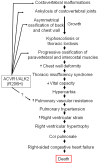Early mortality and cardiorespiratory failure in patients with fibrodysplasia ossificans progressiva
- PMID: 20194327
- PMCID: PMC2827822
- DOI: 10.2106/JBJS.I.00705
Early mortality and cardiorespiratory failure in patients with fibrodysplasia ossificans progressiva
Abstract
Background: Fibrodysplasia ossificans progressiva, a rare genetic disorder of progressive extraskeletal ossification, is the most disabling form of heterotopic ossification in humans. However, little is known about the lifespan or causes of mortality in these patients. We undertook this study to determine the lifespan and causes of mortality in individuals who had fibrodysplasia ossificans progressiva.
Methods: We reviewed comprehensive mortality reports from two large registries of patients with fibrodysplasia ossificans progressiva. Together, these registries comprise >90% of all known patients with this condition in the world. We noted the sex, dates of birth and death, and the cause of death for each individual. We verified the cause of death with extensive medical records, when available. We also collected date of birth, current age, and sex information for each living patient member of the International Fibrodysplasia Ossificans Progressiva Association.
Results: Sixty deaths (thirty male and thirty female patients) were reported in the fibrodysplasia ossificans progressiva community during a thirty-three-year-period. For all sixty patients, the median age at the time of death was forty years (range, three to seventy-seven years). Data were sufficient to establish the cause of death in forty-eight (80%) of the sixty individuals. The median age at the time of death for the forty-eight patients (twenty-four male and twenty-four female patients) with an established cause of death was also forty years. The median lifespan estimated from the 371 individuals in the international fibrodysplasia ossificans progressiva community who were alive and the sixty who had died was fifty-six years (95% confidence interval, fifty-one to sixty years). The most common causes of death in patients with fibrodysplasia ossificans progressiva were cardiorespiratory failure from thoracic insufficiency syndrome (54%; median age, forty-two years) and pneumonia (15%; median age, forty years).
Conclusions: Fibrodysplasia ossificans progressiva is not only an extremely disabling disease but also a condition of considerably shortened lifespan. The most common cause of death in patients with fibrodysplasia ossificans progressiva is cardiorespiratory failure from thoracic insufficiency syndrome.
Figures



Similar articles
-
Proximal tibial osteochondromas in patients with fibrodysplasia ossificans progressiva.J Bone Joint Surg Am. 2008 Feb;90(2):366-74. doi: 10.2106/JBJS.G.00774. J Bone Joint Surg Am. 2008. PMID: 18245597 Free PMC article.
-
Early diagnosis of fibrodysplasia ossificans progressiva.Pediatrics. 2008 May;121(5):e1295-300. doi: 10.1542/peds.2007-1980. Pediatrics. 2008. PMID: 18450872 Free PMC article.
-
Limb swelling in patients who have fibrodysplasia ossificans progressiva.Clin Orthop Relat Res. 1997 Mar;(336):247-53. doi: 10.1097/00003086-199703000-00033. Clin Orthop Relat Res. 1997. PMID: 9060511
-
Fibrodysplasia ossificans progressiva: a current review of imaging findings.Skeletal Radiol. 2018 Aug;47(8):1043-1050. doi: 10.1007/s00256-018-2889-5. Epub 2018 Feb 14. Skeletal Radiol. 2018. PMID: 29445932 Review.
-
Fibrodysplasia ossificans progressiva: Review and research activities in Japan.Pediatr Int. 2020 Jan;62(1):3-13. doi: 10.1111/ped.14065. Pediatr Int. 2020. PMID: 31774601 Review.
Cited by
-
Surgical and Radiological Management of Complicated Uterine Leiomyoma Aided by 3D Models in a Patient with Fibrodysplasia Ossificans Progressiva.Am J Case Rep. 2021 Jun 10;22:e931614. doi: 10.12659/AJCR.931614. Am J Case Rep. 2021. PMID: 34108438 Free PMC article.
-
Molecular Developmental Biology of Fibrodysplasia Ossificans Progressiva: Measuring the Giant by Its Toe.Biomolecules. 2024 Aug 15;14(8):1009. doi: 10.3390/biom14081009. Biomolecules. 2024. PMID: 39199396 Free PMC article. Review.
-
Animal models of fibrodysplasia ossificans progressiva.Dev Dyn. 2018 Feb;247(2):279-288. doi: 10.1002/dvdy.24606. Epub 2017 Dec 1. Dev Dyn. 2018. PMID: 29139166 Free PMC article. Review.
-
Gene Therapy for Fibrodysplasia Ossificans Progressiva: Feasibility and Obstacles.Hum Gene Ther. 2022 Aug;33(15-16):782-788. doi: 10.1089/hum.2022.023. Hum Gene Ther. 2022. PMID: 35502479 Free PMC article. Review.
-
Inhibition of phosphatidylinositol 3-kinase α (PI3Kα) prevents heterotopic ossification.EMBO Mol Med. 2019 Sep;11(9):e10567. doi: 10.15252/emmm.201910567. Epub 2019 Aug 2. EMBO Mol Med. 2019. PMID: 31373426 Free PMC article.
References
-
- Kaplan FS, Glaser DL, Shore EM, Deirmengian GK, Gupta R, Delai P, Morhart R, Smith R, Le Merrer M, Rogers JG, Connor M, Kitterman JA. The phenotype of fibrodysplasia ossificans progressiva. Clin Rev Bone Miner Metab. 2005;3-4:183-8
-
- Kaplan FS, Groppe J, Pignolo RJ, Shore EM. Morphogen receptor genes and metamorphogenes: skeleton keys to metamorphosis. Ann N Y Acad Sci. 2007;1116:113-33 - PubMed
-
- Shore EM, Xu M, Feldman GJ, Fenstermacher DA, Cho T-J, Choi IH, Connor JM, Delai P, Glaser DL, Le Merrer M, Morhart R, Rogers JG, Smith R, Triffitt JT, Urtizberea JA, Zasloff M, Brown MA, Kaplan FS. A recurrent mutation in the BMP type I receptor ACVR1 causes inherited and sporadic fibrodysplasia ossificans progressiva. Nat Genet. 2006;38:525-7 - PubMed
-
- Shore EM, Feldman GJ, Xu M, Kaplan FS. The genetics of fibrodysplasia ossificans progressiva. Clin Rev Bone Miner Metab. 2005;3-4:201-4
Publication types
MeSH terms
Grants and funding
LinkOut - more resources
Full Text Sources
Other Literature Sources

